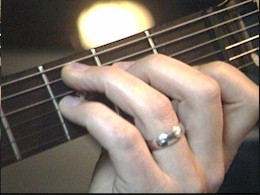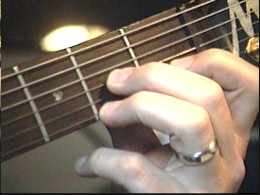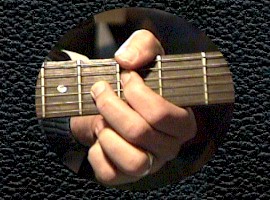Scroll through the lesson and click on notation/video/audio links to load the interactive players.
Please subscribe to get full access to all lessons for only $7.95/month PLUS 1 week free trial.

Riff Interactive lessons are
LESS expensive and
MORE interactive than alternatives!
More Info
|
|

Blues Guitar For
Beginners II
Lesson 6
Lyle: In this lesson for beginners you will learn a couple ways to play
a 12 bar blues progression in the key of G, as well as a G Minor Blues scale
solo.
Lyle: Here's your jam track and chord chart for
this lesson:
chord
chart

Lyle: Here's the G7 chord in the "open"
position:
G7

Lyle: Next you'll need to learn the C7 chord in
the open position:
C7

radica: The Beatles must have use the 7th chords a lot as
it sounds like it here.
Lyle: Yes they did. You're learning another "I - IV - V" chord
progression in G. The G7 is the I chord, the C7 is the IV chord, and the D7 is
the V chord:
D7

Lyle: The I - IV - V is the most popular
progression. G7, C7, and D7 are called "Dominant" chords. They are not major or
minor, but "Dominant". This means they have a major triad and a flatted 7th in
them.
BigTX:
How can all dominants sound good
together?
Lyle:
Dominants have the blues sound to them compared to major and minor
chords.Lyle: Now try playing a basic rhythm to the whole
12 bar progression. Strum down on the first beat of each measure. There are 4
beats in each measure.
Lyle: If you can play rhythm riff 1, that means
you are jammin' the blues! As easy as it is, it still sounds
cool.
Lyle: Once you think you're ready, try playing
right along to the looping jam track.
Lyle: Let's try playing the G7, C7, and D7 a
different way, which will give you a different sound. This way uses your thumb
for the bass note!
G7 with
thumb

Lyle: Mute the 5th, 2nd, and 1st strings by
simply relaxing your grip.
andrey: With what finger should I mute the 5th
string?
Lyle: Many old school blues players use this
chord shape. Jimi Hendrix used his thumb many times to play chord
shapes.
Lyle: Mute the 5th string with either the tip of
your index finger or the tip of your
thumb.
Lyle: The nice thing about this chord shape is
that you can slide it around the neck to get to any other dominant chord. The
root is on the 6th string. Here's the whole progression using this chord
shape:
len: That shape
is going to take some serious work over here :)
Lyle: It
is a little harder to play than using just the open chords so
beware.
Lyle: Now you have two ways to play a basic
rhythm to this chord progression.
Lyle: The best scale to use to solo with against
this blues jam might be the Gm Blues scale:
Lyle: In
the next lesson you'll learn some real cool blues licks and a solo or two using
this very scale.
Lyle: For now you can play this scale ascending
and descending against the 12 bar progression. You did this in the key of A in
an earlier lesson. Now try it here in the key of G:
Lyle:
Can everyone play the Gm Blues solo in time with the TAB or jam
track?
Pacer:
yup
Bob:
Yeah
John_G: Yep
-- got it :)
paulb: pretty much yes
andrey: yes,
it's ok
Lyle: Good! It can be a little bit of a challenge
for some beginners.
Lyle: Next lesson you'll be working on cool blues
riffs with bends, hammer-ons, and pull-offs, using this scale and jam track.
We'll put together a good solo or two.
Lyle: That's all for this lesson. Thanks everyone, see you
at the next lesson!
|
<< load notation from left
|
|
<< load audio from left
|
<< load audio from left
|